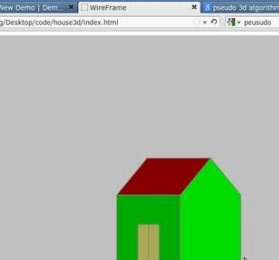VB.Net中文教程(5)程序多重定义_.NET教程_编程技术
2013-12-20 14:30:59
[小 大]
已经帮助:人解决问题
程序|教程|中文
1. 程序成员的多重定义「程序多重定义」(Function Overloading)又称为「程序重复定义」。它让对象更具弹性�能处理多样化之讯息。这观念源于日常生活经验。例如�我们常说�
◎ 猫 玩 绣球
◎ 猫 玩 老鼠
◎ 猫 玩 鱼
猫玩绣球与玩老鼠之玩法不尽相同。但何以使用同一动词──「玩」呢�也许人们认为其目的是一致的�猫获得快乐。上述的「猫」为类别�而某只猫是对象。例如�加菲猫是对象�它可接受讯息──
其中�「玩」代表着动作和过程�而绣球、老鼠及鱼则是「玩」之对象。回想�在程序中�「程序」代表一项动作及过程�而「自变量值」则为程序之处理对象。因之�上图可表示为──
图1、 play()之多重定义
OOP 程序设计之理想为�让程序之写法与人们日常生活经验吻合�于是设计个Play()程序�让它能接受不同型态之资料做为处理对象。上述Play()已具「多重定义」�其特点是──
1. 程序名称相同�例如�Play()。
2. 自变量不同�例如�老鼠和鱼。
因猫玩绣球和玩老鼠的方法略有不同�例如老鼠是活的而绣球是死的�其玩的过程亦不尽相同。为了表示动作与过程之不同�Play()程序内之指令也有所不同。例如�
写VB程序时�其格式必须是──
Class Cat
Public Overloads Sub Play(绣球)
指令
.......
End Sub
Public Overloads Sub Play(老鼠)
指令
.......
End Sub
Public Overloads Sub Play(鱼)
指令
.......
End Sub
End Class
这就是「程序成员多重定义」了。Cat 类别含有三种Play()之定义�其自变量不同而且内部指令亦不相同。于是Play()程序能接受不同之自变量�并执行不同之指令�使得Play()具弹性了。请看个程序──
'ex01.bas
Imports System.ComponentModel
Imports System.Drawing
Imports System.WinForms
'-------------------------------------------------------
Class Example
Public Overloads Sub Display()
MessageBox.Show("****")
End Sub
Public Overloads Sub Display(ByVal r As Integer)
MessageBox.Show(str(r))
End Sub
Public Overloads Sub Display(ByVal f As Double)
MessageBox.Show(str(f + 2))
End Sub
Public Overloads Sub Display(ByVal s As String)
MessageBox.Show(s)
End Sub
End Class
'--------------------------------------------------------
Public Class Form1
Inherits System.WinForms.Form
Public Sub New()
MyBase.New()
Form1 = Me
'This call is required by the Win Form Designer.
InitializeComponent()
'TODO: Add any initialization after the InitializeComponent() call
End Sub
'Form overrides dispose to clean up the component list.
Public Overrides Sub Dispose()
MyBase.Dispose()
components.Dispose()
End Sub
#Region " Windows Form Designer generated code "
........
#End Region
Protected Sub Form1_Click( ByVal sender As Object, ByVal
e As System.EventArgs)
Dim a As New Example()
a.Display()
a.Display("Taiwan")
a.Display(80)
a.Display(100.5)
End Sub
End Class
此程序输出如下� ****
Taiwan
80
102.5
这Example类别比较特殊�没有资料成员�但含有一个程序成员叫Display() 。而Display()有 4个不同之版本(定义)�可任君(计算机)挑选。计算机藉比对自变量来挑选「最相配」之Display()程序。
例如�计算机执行到指令──
a.Display("Taiwan")
由于自变量── "Taiwan"是字符串�其型态应配上String�所以计算机挑选并且执行第 4个程序── Display( ByVal s As String ) 。同理�当计算机执行到指令──
a.Display(100.5)
由于自变量──100.5之型态为Double�所以计算机选上并执行第 3个Display()程序── Display(ByVal f As Double )。同一程序名称但有数个不同之定义�各有不同之自变量及内部指令�此种现象就是「程序的多重定义」。
请再看个例子──
'ex02.bas
Imports System.ComponentModel
Imports System.Drawing
Imports System.WinForms
'--------------------------------------------------
Class Sum
Private s As Integer
Public Overloads Sub Add()
s = 3 + 5
End Sub
Public Overloads Sub Add(ByVal x As Integer)
s = x + 5
End Sub
Public Overloads Sub Add(ByVal x As Integer, ByVal y As Integer)
s = x + y
End Sub
Public Sub Show()
MessageBox.Show("Sum = " + str(s))
End Sub
End Class
'---------------------------------------------------
Public Class Form1
Inherits System.WinForms.Form
Public Sub New()
MyBase.New()
Form1 = Me
'This call is required by the Win Form Designer.
InitializeComponent()
'TODO: Add any initialization after the InitializeComponent() call
End Sub
'Form overrides dispose to clean up the component list.
Public Overrides Sub Dispose()
MyBase.Dispose()
components.Dispose()
End Sub
#Region " Windows Form Designer generated code "
........
#End Region
Protected Sub Form1_Click( ByVal sender As Object, ByVal
e As System.EventArgs)
Dim a As New Sum()
a.Add()
a.Show()
a.Add(80)
a.Show()
Dim b As New Sum()
b.Add(100, 27)
b.Show()
End Sub
End Class
此程序输出如下� Sum = 8
Sum = 85
Sum = 127
当计算机执行到指令── b.Add( 100, 27 ),由于有两个自变量�且型态皆为Integer�计算机就选上并执行第三个Add() 程序。此时计算机把100传给x�而27传给y。这多重定义之观念�也常用于建构者程序上。例如�
'ex03.bas
Imports System.ComponentModel
Imports System.Drawing
Imports System.WinForms
'---------------------------------------------------
Class Rectangle
Private height As Integer, Width As Integer
Public Overloads Sub New()
height = 0
width = 0
End Sub
Public Overloads Sub New(ByVal k As Integer)
height = k
width = k
End Sub
Public Overloads Sub New(ByVal h As Integer, ByVal w As Integer)
height = h
width = w
End Sub
Public Sub ShowArea()
MessageBox.Show("Area = " + str(height * width))
End Sub
End Class
'---------------------------------------------------
Public Class Form1
Inherits System.WinForms.Form
Public Sub New()
MyBase.New()
Form1 = Me
'This call is required by the Win Form Designer.
InitializeComponent()
'TODO: Add any initialization after the InitializeComponent() call
End Sub
'Form overrides dispose to clean up the component list.
Public Overrides Sub Dispose()
MyBase.Dispose()
components.Dispose()
End Sub
#Region " Windows Form Designer generated code "
.......
#End Region
Protected Sub Form1_Click( ByVal sender As Object, ByVal
e As System.EventArgs)
Dim r1 As New Rectangle()
Dim r2 As New Rectangle(8)
Dim r3 As New Rectangle(5, 6)
r1.ShowArea()
r2.ShowArea()
r3.ShowArea()
End Sub
End Class
此程序输出� Area = 0
Area = 64
Area = 30
宣告对象时�若未给予自变量值�计算机呼叫New()�若给一个自变量值── 8�就呼叫 New(ByVal k As Integer) �若给二个自变量值──5 及 6�则呼叫New(ByVal h As Integer, ByVal w As Integer)。请再看一个例子:
'ex04.bas
Imports System.ComponentModel
Imports System.Drawing
Imports System.WinForms
'-------------------------------------------------------------------------------------------------
Class Rectangle
Private height As Integer, Width As Integer
Public Sub New(ByVal h As Integer, ByVal w As Integer)
height = h
width = w
End Sub
Public Function Area() As Integer
Area = height * width
End Function
Public Overloads Function CompareWith(ByVal a As Integer) As Integer
Dim d As Integer
d = Area() - a
If d <> 0 Then
CompareWith = 1
Else
CompareWith = 0
End If
End Function
Public Overloads Function CompareWith(ByVal r As Rectangle) As Integer
Dim d As Integer
d = Area() - r.Area()
If d <> 0 Then
d = 1
End If
CompareWith = d
End Function
Public Overloads Function CompareWith( ByVal x As Rectangle, ByVal
y As Rectangle) As Integer
Dim d As Integer
d = x.Area() - y.Area()
If d <> 0 Then
d = 1
End If
CompareWith = d
End Function
End Class
'----------------------------------------------------------------------------------------------
Public Class Form1
Inherits System.WinForms.Form
Public Sub New()
MyBase.New()
Form1 = Me
'This call is required by the Win Form Designer.
InitializeComponent()
'TODO: Add any initialization after the InitializeComponent() call
End Sub
'Form overrides dispose to clean up the component list.
Public Overrides Sub Dispose()
MyBase.Dispose()
components.Dispose()
End Sub
#Region " Windows Form Designer generated code "
........
#End Region
Protected Sub Form1_Click( ByVal sender As Object, ByVal
e As System.EventArgs)
Dim r1 As New Rectangle(10, 50)
Dim r2 As New Rectangle(20, 25)
If r1.CompareWith(400) = 0 Then
MessageBox.Show("EQUAL")
Else
MessageBox.Show("NOT EQUAL")
End If
If r1.CompareWith(r2) = 0 Then
MessageBox.Show("EQUAL")
Else
MessageBox.Show("NOT EQUAL")
End If
If r1.CompareWith(r1, r2) = 0 Then
MessageBox.Show("EQUAL")
Else
MessageBox.Show("NOT EQUAL")
End If
End Sub
End Class
此程序输出� NOT EQUAL
EQUAL
EQUAL
如此�CompareWith()程序就有三种用途了�如果您想增加其它用途�可尽情地再定义它。r1.CompareWith(400)呼叫第1个CompareWith(),比比看r1面积是否大于400;r1.ComapreWith(r2) 呼叫第2个CompareWith(),比比看r1面积是否大于r2的面积;r1.ComapreWith(r1, r2) 比比看r1面积是否大于r2的面积。如果没有使用多重定义方法,这三个程序名称不能相同。例如�上述程序可改写为──
'ex05.bas
Imports System.ComponentModel
Imports System.Drawing
Imports System.WinForms
'-------------------------------------------------------------------------------------------
Class Rectangle
Private height As Integer, Width As Integer
Public Sub New(ByVal h As Integer, ByVal w As Integer)
height = h
width = w
End Sub
Public Function Area() As Integer
Area = height * width
End Function
Public Function CompareWithInteger(ByVal a As Integer) As Integer
Dim d As Integer
d = Area() - a
If d <> 0 Then
d = 1
End If
CompareWithInteger = d
End Function
Public Function CompareWithRectangle(ByVal r As Rectangle) As Integer
Dim d As Integer
d = Area() - r.Area()
If d <> 0 Then
d = 1
End If
CompareWithRectangle = d
End Function
Public Function CompareTwoRectangle( ByVal x As Rectangle, ByVal
y As Rectangle) As Integer
Dim d As Integer
d = x.Area() - y.Area()
If d <> 0 Then
d = 1
End If
CompareTwoRectangle = d
End Function
End Class
'---------------------------------------------------------------------------------------------
Public Class Form1
Inherits System.WinForms.Form
Public Sub New()
MyBase.New()
Form1 = Me
'This call is required by the Win Form Designer.
InitializeComponent()
'TODO: Add any initialization after the InitializeComponent() call
End Sub
'Form overrides dispose to clean up the component list.
Public Overrides Sub Dispose()
MyBase.Dispose()
components.Dispose()
End Sub
#Region " Windows Form Designer generated code "
........
#End Region
Protected Sub Form1_Click( ByVal sender As Object, ByVal
e As System.EventArgs)
Dim r1 As New Rectangle(10, 50)
Dim r2 As New Rectangle(20, 25)
If r1.CompareWithInteger(400) = 0 Then
MessageBox.Show("ggg EQUAL")
Else
MessageBox.Show("NOT EQUAL")
End If
If r1.CompareWithRectangle(r2) = 0 Then
MessageBox.Show("EQUAL")
Else
MessageBox.Show("NOT EQUAL")
End If
If r1.CompareTwoRectangle(r1, r2) = 0 Then
MessageBox.Show("EQUAL")
Else
MessageBox.Show("NOT EQUAL")
End If
End Sub
End Class
此程序输出�
NOT EQUAL
EQUAL
EQUAL
由于各程序名称不相同,您就得记忆各程序之名字�徒增记忆负担而且易于犯错�并不合乎人们生活习惯。因之�VB的多重定义观念�能增加程序之弹性及亲切感。
程序多重定义情形并不限于单一类别之内,也可以发生于父子类别之间。例如:
'ex06.bas
Imports System.ComponentModel
Imports System.Drawing
Imports System.WinForms
'------------------------------------------------------------------------------------------
Public Class Person
Private name As String
Private age As Integer
Public Sub New()
End Sub
Public Sub SetValue(ByVal na As String, ByVal a As Integer)
name = na
age = a
End Sub
Public Function birthDay() As Integer
birthDay = 2001 - age
End Function
Public Sub Display()
Messagebox.Show("Name: " + name + " Age: " + str(age))
End Sub
End Class
Public Class Teacher
Inherits Person
Private salary As Decimal
Public Overloads Sub SetValue( ByVal na As String, ByVal a As Integer, ByVal
sa As Decimal)
SetValue(na, a)
salary = sa
End Sub
Public Sub pr()
MyBase.Display()
Messagebox.Show("Salary: " + str(salary))
End Sub
End Class
Public Class Student
Inherits Person
Private student_number As Integer
Public Overloads Sub SetValue( ByVal na As String, ByVal a As Integer, ByVal
no As Integer)
SetValue(na, a)
student_number = no
End Sub
Public Sub pr()
MyBase.Display()
Messagebox.Show("StudNo: " + str(student_number))
End Sub
End Class
'-----------------------------------------------------------------------------------------
Public Class Form1
Inherits System.WinForms.Form
Public Sub New()
MyBase.New()
Form1 = Me
'This call is required by the Win Form Designer.
InitializeComponent()
'TODO: Add any initialization after the InitializeComponent() call
End Sub
'Form overrides dispose to clean up the component list.
Public Overrides Sub Dispose()
MyBase.Dispose()
components.Dispose()
End Sub
#Region " Windows Form Designer generated code "
........
#End Region
Protected Sub Form1_Click( ByVal sender As Object, ByVal
e As System.EventArgs)
Dim x As New Person()
x.SetValue("Alvin", 32)
Dim y As New Student()
y.SetValue("Tom", 36, 11138)
x.Display()
y.pr()
End Sub
End Class
Teacher类别从Person继承了SetValue() ──
SetValue(ByVal na As String, ByVal a As Integer)
自己又重复定义一个新的SetValue()程序──
SetValue(ByVal na As String, ByVal a As Integer, ByVal no As Integer)
共有两个SetValue()可用。指令x.SetValue("Alvin", 32)呼叫第1个SetValue();指令y.SetValue("Tom", 36, 11138)呼叫第1个SetValue()。
兹在扩充一个子类别如下:
'ex07.bas
Imports System.ComponentModel
Imports System.Drawing
Imports System.WinForms
'------------------------------------------------------------------------------------------
Public Class Person
Private name As String
Private age As Integer
Public Sub New()
End Sub
Public Sub SetValue(ByVal na As String, ByVal a As Integer)
name = na
age = a
End Sub
Public Function birthDay() As Integer
birthDay = 2001 - age
End Function
Public Overridable Sub Display()
Messagebox.Show("Name: " + name + " Age: " + str(age))
End Sub
End Class
Public Class Teacher
Inherits Person
Private salary As Decimal
Public Overloads Sub SetValue( ByVal na As String, ByVal a As Integer, ByVal
sa As Decimal)
SetValue(na, a)
salary = sa
End Sub
Public Overrides Sub Display()
MyBase.Display()
Messagebox.Show("Salary: " + str(salary))
End Sub
End Class
Public Class Student
Inherits Person
Private student_number As Integer
Public Overloads Sub SetValue( ByVal na As String, ByVal a As Integer, ByVal
no As Integer)
SetValue(na, a)
student_number = no
End Sub
Public Overrides Sub Display()
MyBase.Display()
Messagebox.Show("StudNo: " + str(student_number))
End Sub
End Class
'-----------------------------------------------------------------------------------------
Public Class Form1
Inherits System.WinForms.Form
Public Sub New()
MyBase.New()
Form1 = Me
'This call is required by the Win Form Designer.
InitializeComponent()
'TODO: Add any initialization after the InitializeComponent() call
End Sub
'Form overrides dispose to clean up the component list.
Public Overrides Sub Dispose()
MyBase.Dispose()
components.Dispose()
End Sub
#Region " Windows Form Designer generated code "
........
#End Region
Protected Sub Form1_Click( ByVal sender As Object, ByVal
e As System.EventArgs)
Dim x As New Person()
x.SetValue("Alvin", 32)
Dim y As New Student()
y.SetValue("Tom", 36, 11138)
x.Display()
y.Display()
End Sub
End Class
此程序输出�
Name: Alvin Age: 32
Name: Tom Age: 36
StudNo: 11138
此时�Student 类别含有两个SetValue()程序,一个是从Person类别继承而来,另一个是自行定义的。如果上述Form1_Click()内的指令更改如下:
Dim y As New Student()
y.SetValue("Tom", 36, 5000.25) 'Error!
y.Display()
虽然SetValue("Tom", 36, 5000.25)合乎Teacher的SetValue()程序的参数,但是Student并非Person的子类别,没有继承Student的SetValue(),所以错了。n
(责任编辑:)
友情链接:联系人:QQ370158739




